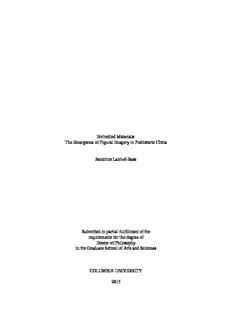
Embodied Materials: The Emergence of Figural Imagery in Prehistoric China Sandrine Larrivé ... PDF
Preview Embodied Materials: The Emergence of Figural Imagery in Prehistoric China Sandrine Larrivé ...
Embodied Materials: The Emergence of Figural Imagery in Prehistoric China Sandrine Larrivé-Bass Submitted in partial fulfillment of the requirements for the degree of Doctor of Philosophy in the Graduate School of Arts and Sciences COLUMBIA UNIVERSITY 2015 © 2015 Sandrine Larrivé-Bass All rights reserved ABSTRACT Embodied Materials: The Emergence of Figural Imagery in Prehistoric China Sandrine Larrivé-Bass This dissertation explores the emergence of figuration in prehistoric China. It approaches the topic by focusing on image-makers’ engagement with the materials they used to fashion figural works. Chapter 1 presents a survey of zoomorphic and anthropomorphic images created from the Epipaleolithic through the Neolithic periods. It highlights a multiplicity of forms, materials and representational approaches while uncovering recurring patterns. Chapter 2 introduces the principal theories scholars have applied to discuss this corpus, and draws out their similarity with paradigms used in Western scholarship on prehistoric art. The discussion further draws attention to a bi-directional influence exerted on the reception of prehistoric imagery in Europe and China. Chapter 3 focuses on images produced prior to or around 5,000 BCE, and repositions their emergence in the context of broader interests in materiality and representation. The analysis uncovers trends and explores circumstances that notably led image-makers separated in time and space to represent human heads as flat entities. Chapter 4 investigates the role of pareidolia in the emergence of images. It reveals that perceptive imagination informed the creation of some works, when craftspeople drew inspiration from forms in raw materials or artifacts. Chapter 5 explores the possibility that image-makers sought to achieve material- representation synergies. The discussion presents a new taxonomic model addressing materiality and the sensory channels through which figurative images are perceived, and it describes how these factors possibly constituted a core aspect of mimesis. The analysis proposes that some image-makers employed both visual and tactile qualities of substances to represent animals and human beings. TABLE OF CONTENT LIST OF MAPS vi LIST OF FIGURES vii-lix ACKNOWLEDGEMENTS lx-lxii INTRODUCTION 1 CHAPTER 1 Early Figural Imagery in China: An Overview of Artifacts 18 Introduction………………………………………………………………… …… 18 Figural Representations in the Middle Paleolithic: Hypothetical Cases…… …… 20 Late Paleolithic and Epipaleolithic Representations in China…………………… 25 The Early Bird Special…………………………………………………… 29 The Neolithic Period………………………………………………………........... 30 Neolithic Figural Imagery: Southern China……………………………………… 31 Neolithic Figural Imagery: Northern China……………………………………… 39 Large-Scale and Static Imagery………………………………………….. 39 Smaller-Scale and Movable Imagery………………………………. ……. 47 Anthropomophs…………………………………………………... 49 Zoomorphs……………………………………………………….. 64 Conclusion……………………………………………………………………….. 78 CHAPTER 2 Early Figural Imagery in China: An Overview of Theories 81 Introduction………………………………………………………………………. 81 Historiography and Epigraphy………………………………………………….... 84 Rituals and Cosmology…………………………………………………………... 89 i Interpretational Models Influenced by Western Scholarship………………….…. 93 Diffusionism…………………………………………………………..…. 96 Totemism……………………………………………………………..….. 99 Shamanism…………………………………………………………..…… 107 Matriarchy…………………………………………………………..……. 114 Goddess Worship…………………………………………………..…….. 117 Fertility Rites……………………………………………………...……… 124 Worldwide Prehistoric Imagery and China……………………………..………… 129 Conclusion……………………………………………………………..…………. 133 CHAPTER 3 Early Interests in Material Synergies and Figural Representation 135 Introduction……………………………………………………………………….. 135 Materials First Embodied as Figures in China………………………………….... 137 Materiality and Intentionality…………………………………………………...... 144 Cross-Referential Links among Materials Used to Craft Artifacts…………......… 149 Pottery, Basketry, Hide Pouches and Fiber Ropes……………………..… 149 Ornaments: Stone for Shell, Shell for Turtle Scutes, Nephrite for Bone, Shell for Enamel………………………………………………........ 151 Representation and the Emergence of Figural Images in Northeastern China...…. 157 Emergence of Figural Images in Nothern China: Dearth of Figures, Styles and External Influence………………………………………………………..….. 160 Paucity of Early Images……………………………………………..…… 161 Starting from Scratch…………………………………………………….. 168 Anthropomorphic Heads…………………………………………. 170 ii High Frequency of Facial Features Defined by Y-Shaped Configurations Marking the Nose and Eyebrows………………… 174 Human Heads Represented as en Face Engravings or Sculpted as Flattened or Flat……………….………………………….…..... 177 Human Faces: Expressions and Emotions……………………..…. 185 Barely Representational Images……………………………..…… 188 Conclusion…………………………………………………………………..……. 190 CHAPTER 4 The Role of Pareidolia in the Emergence of Prehistoric Imagery 193 Introduction……………………………………………………………………….. 193 Pareidolia in the Study: Psychology, Neuroscience, Religion, Art History and Prehistory…………………………………………………………….…… 194 Pareidolia and Chinese Culture…………………………………………………... 209 Terminology……………………………………………………………………… 212 Pareidolia, Terminology and Metaphors…………………………………………. 213 Pareidolia: A Phenomenon in the Emergence of Figural Representation in Prehistoric China……………………………………………………………….. 217 Natural Shape of Bones, Plastrons and Antlers…………………………… 218 Reflexive Pareidolia……………………………………………………..... 227 Pottery Components………………………………………………. 228 Pottery Shape……………………………………………………… 230 Apertures on Ornaments and Tools……………………………….. 234 Double Apertures on Blades and Tools…………………………… 238 Conclusion………………………………………………………………………… 242 iii CHAPTER 5 Perception, Materiality and Mimesis at the Core of Figural Representation 244 Introduction………………………………………………………………………. 244 Perception, Culture and the Arts………………………………………………..... 246 Senses, Materiality, Craft and the Arts………………………………………....... 251 Approaching Mimesis Beyond Form Alone…………………………………..…. 255 Shaping Sensory Habits: Now and Then…………………………………….…... 258 Mimesis and Imitation Beyond the Arts……..…………………………….…….. 261 Mimesis and Mimicry as Form Production………………………………..…….. 265 Mimicry Differs from Figural Representation…………………………..……….. 266 Biological Mimicry and Classificatory Systems………………………...……….. 267 A New Taxonomic Model……………………………………………..…………. 269 Approach to Material Interests and Sensory Habits in Prehistoric China…..……. 272 Material Preferences………………………………………………………..…….. 276 The Case for Birds………………………………………………..………. 276 The Case for Pigs……………………………………………….……....... 277 The Case for Turtles……………………………………………………... 278 The Case for Fish……………………………………………………….... 279 Tactility and Metaphoric Impulse……………………………………………..…. 282 Tactility of Exclusivity………………………………………………………...…. 284 Material Choices at Anban…………………………………………………..…… 288 Of Humans and Frogs…………………………………………………………….. 292 Materiality, Pareidolia and Mimesis……………………………………………... 295 Conclusion……………………………………………………………………..…. 296 CONCLUSION 298 iv TIME LINE OF NEOLITHIC CULTURES MENTIONED 308 MAPS 309 FIGURES 315 BIBLIOGRAPHY 437 v LIST OF MAPS Map 1. Sites mentioned in the Introduction Map 2. Administrative map of China showing provinces for sites and images discussed in Chapter One Map 3. Significant sites mentioned in Chapter Three Map 4. Sites that yielded figural representations inspired by the forms of bones, plastrons, antlers and objects Map 5. Sites for images discussed in Chapter Five vi
Description: